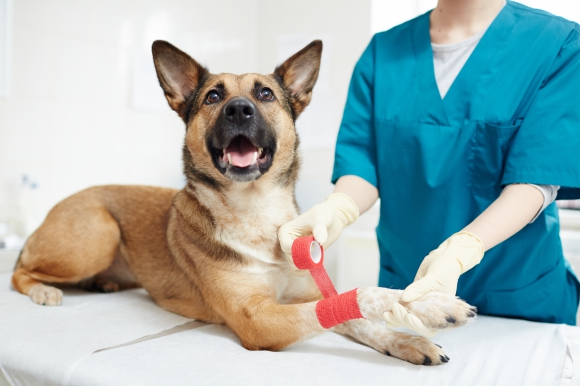


ASK US
Basic Pet First Aid Procedures
ALWAYS REMEMBER- ALL EMERGENCY FIRST AID ADMINISTERED TO YOUR PET SHOULD BE FOLLOWED BY IMMEDIATE VETERINARY CARE.
In any emergency, always transport your pet to a veterinary clinic as soon as possible. The following are a few examples of basic first aid procedures for different emergencies, that owners can preform before and on the way to see a veterinarian.
o Bleeding or open wounds:
If your pet is bleeding or has an open wound, apply and hold direct pressure to the affected area with a clean towel.
DO NOT attempt to bandage any limb yourself, as this can compromise circulation.
Remember an injured pet may be in pain and may try to bite, scratch, or get away so move slowly and approach the animal with caution.
o Heatstroke or exhaustion:
This may be brought on by exertion, heavy exercise, increased ambient temperature, or humidity.
Just remember it can affect any breed.
A digital rectal thermometer can be used to measure your pet’s temperature. A normal temperature should not be above 102.5 degrees F.
If their temperature is elevated place a cool, wet towel around your pet’s head or paws and change towels frequently. DO NOT use ice or ice water.
Call your veterinarian immediately.
o Insect bites and stings:
Seek veterinary care immediately if you notice any signs of hives or swelling. Anaphylaxis, although rare, is a life threatening condition (allergic reaction) that can develop.
o Poisoning:
If you suspect poisoning, contact your local veterinarian for treatment instructions.
If you know your pet consumed something toxic, immediately remove the item from that area but DO NOT discard it. Specific information from the product label could be important for appropriate treatment.
There is also a 24/7 Pet Poison Helpline, provided for a fee. That phone number is 1-855-764-7661.
o Seizure:
Leave a pet that is having a seizure alone until the episode subsides.
Try to remove any objects from the area that could harm the pet.
Note how long the seizure lasts.
Call your veterinarian at the end of the seizure or if the seizure has not stopped after three minutes.
Always make sure to call ahead to the veterinary clinic if possible to alert of an incoming emergency. Let the veterinary team know when you have arrived and allow them to assess your pet and move it into the hospital if necessary. 



